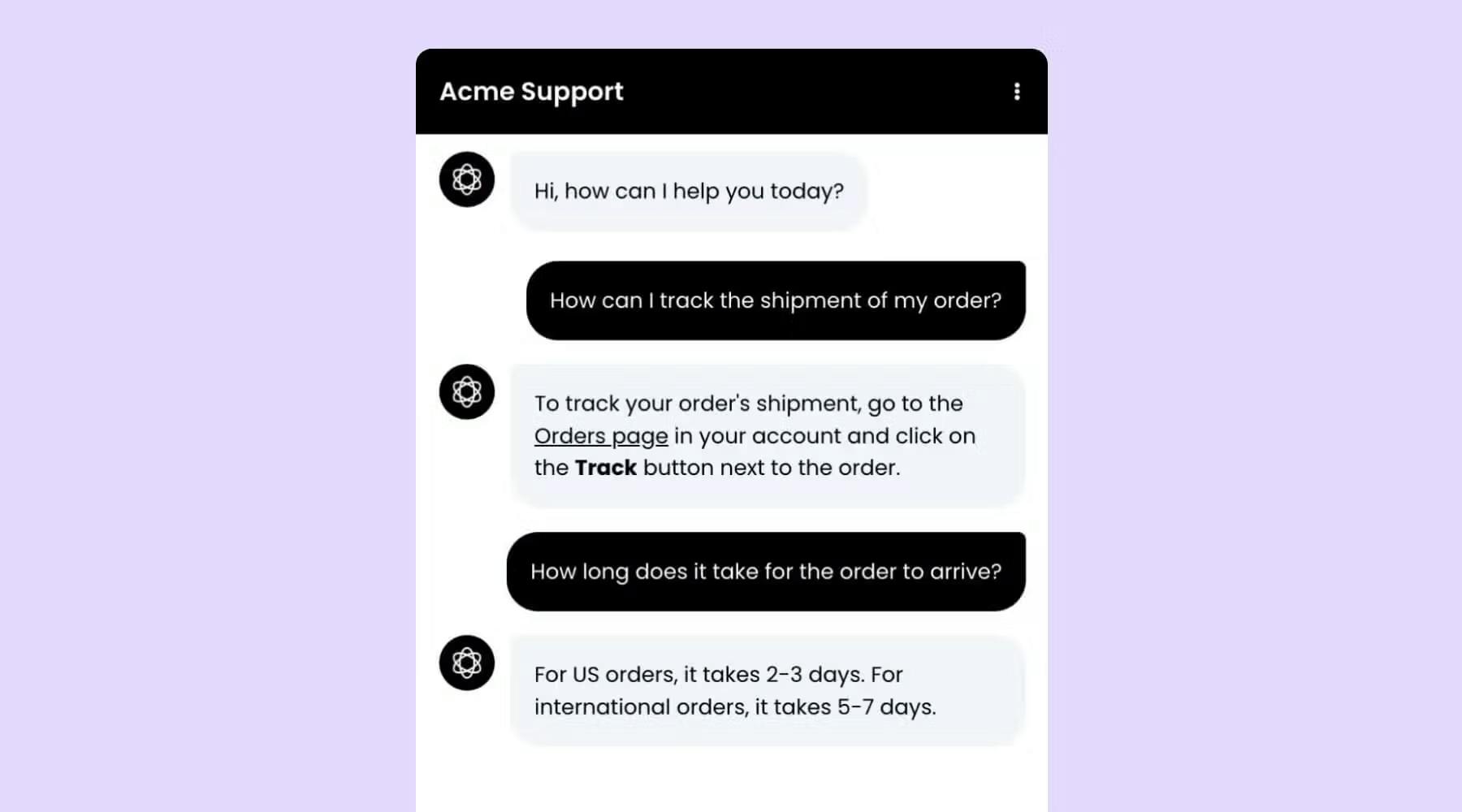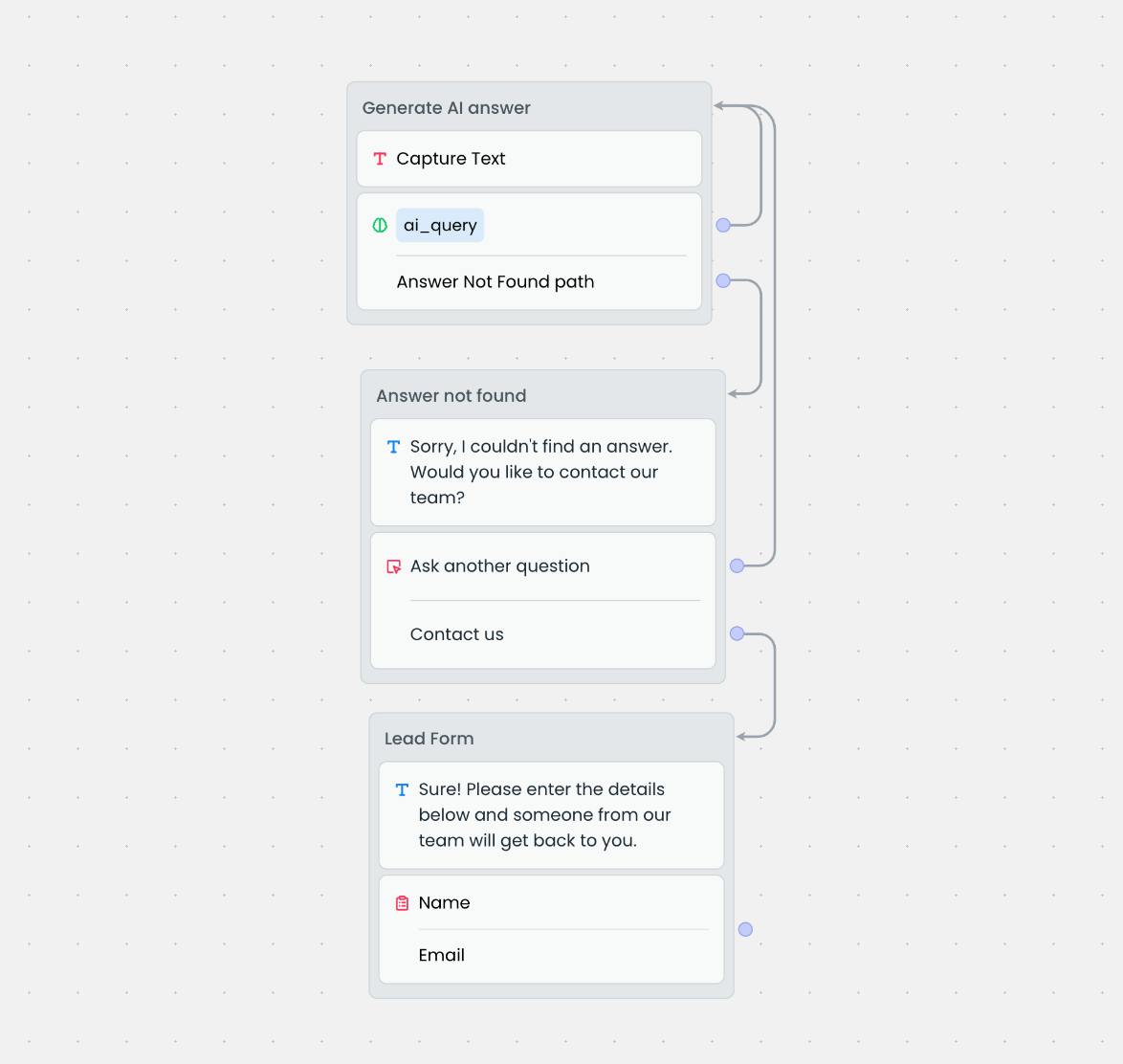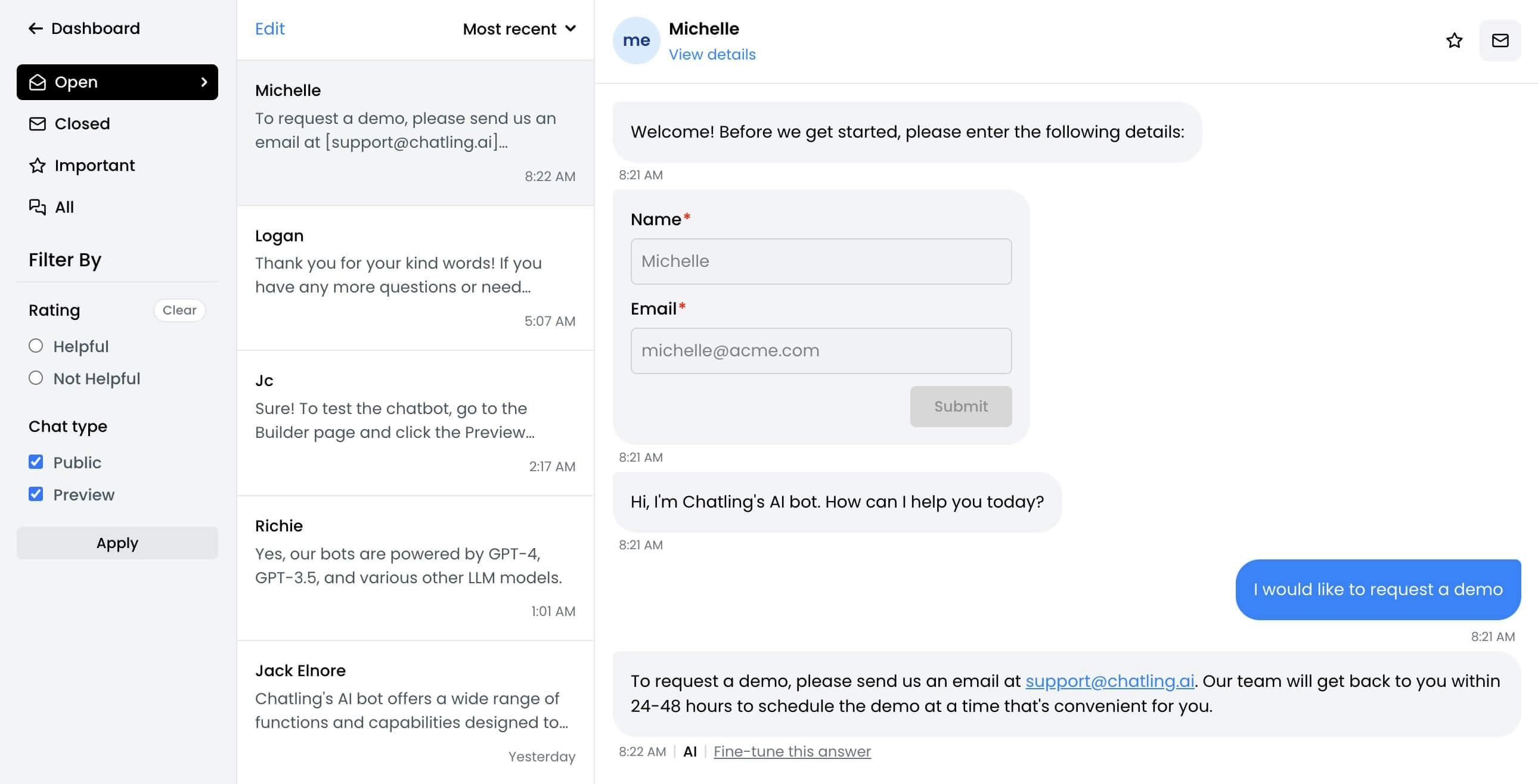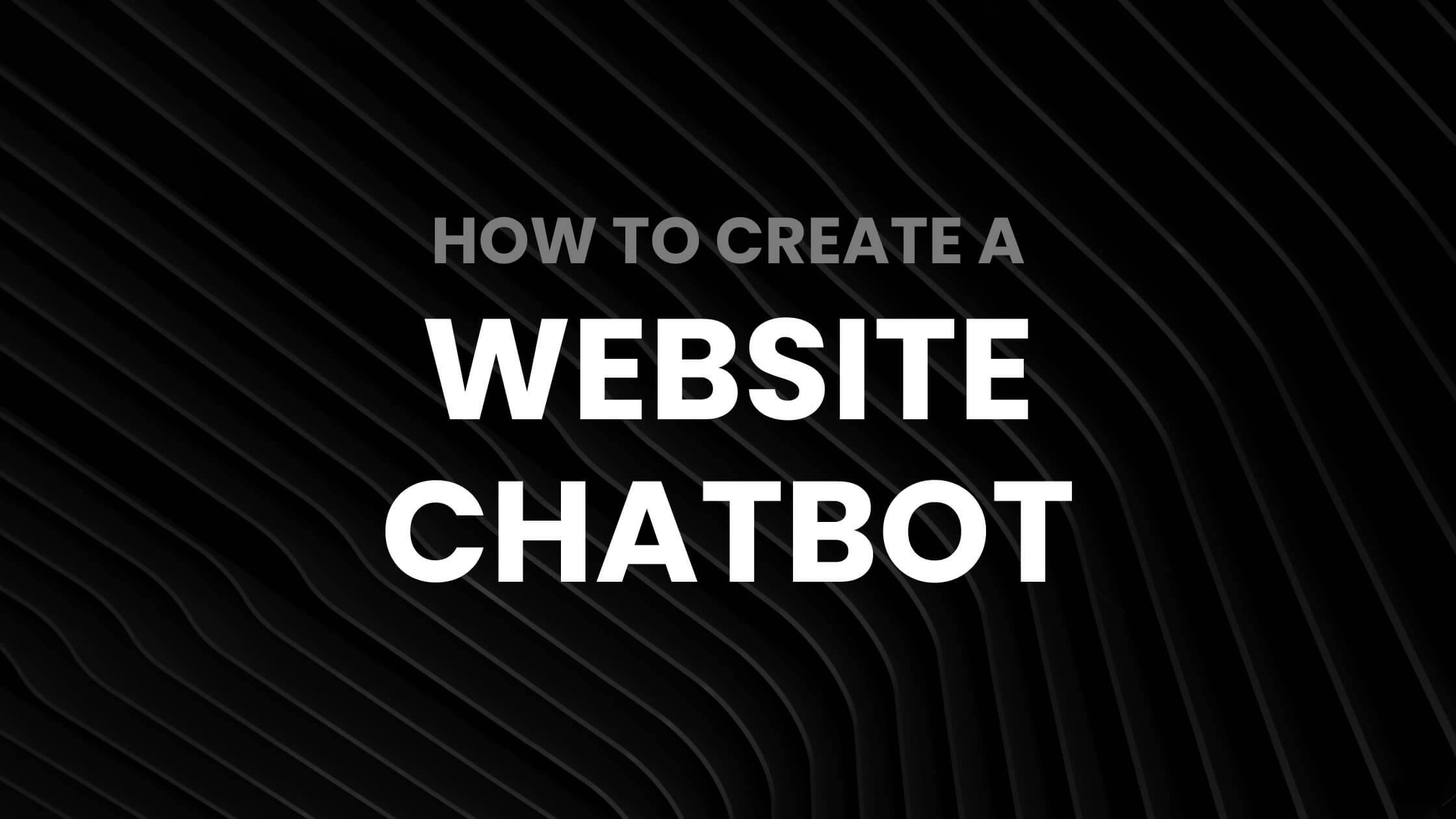Helpful Summary
- Overview: We guide you through creating a chatbot to enhance user experience and website engagement. Our guide covers the development basics for seamless integration.
- Why you can trust us: Chatling has supported numerous businesses, including Fast Transcript, Swampfox, MRPeasy, and others, showcasing our capability to improve customer service and operations through our technology.
- Why this is important: Chatbots provide 24/7 customer support, improving service quality, efficiency, and data analysis for business growth.
- Action points: We recommend starting by determining your chatbot's purpose, choosing the best platform, designing conversation flows, building and training your chatbot, and implementing and continuously improving it on your website.
- Further research: Explore platforms and technologies for chatbot development to find the best fit for your website's needs.
Curious about how to enhance user experience and boost customer engagement on your website? Creating a chatbot can be a game-changer.
But where do you start? Understanding the ins and outs of chatbot development is crucial for a seamless integration.
In this Chatling article, we’ll explore the steps of crafting a chatbot tailored to your website's needs and maximizing its potential.
- Why Listen To Us?
- What are Chatbots for Websites?
- Benefits of Having a Chatbot on Your Website
- How To Create a Chatbot For Your Website
- 1. Determine the Purpose of your Chatbot
- 2. Choose a Platform
- 3. Design the Conversation Flow
- 4. Build and Train the Chatbot
- 5. Implement the Chatbot on Your Website
- 6. Monitor and Improve
- 7. Provide Ongoing Maintenance and Support
- Best Practices When Creating A Chatbot for a Website
- 1. Understand Your Audience
- 2. Keep the Conversation Natural and User-Friendly
- 3. Provide Value and Assistance
- 4. Offer Seamless Integration and Handoff
- Conclusion
Why Listen To Us?
At Chatling, we're not just another chatbot provider – we're your strategic partner in revolutionizing customer service.
With our cutting-edge technology and unwavering commitment to excellence, we've helped countless businesses like yours enhance their customer interactions and streamline operations.
Our track record speaks for itself–our intuitive platform, unmatched accuracy, and personalized support have earned us the trust of industry leaders.
What are Chatbots for Websites?

Chatbots for websites are automated tools designed to interact with users and provide assistance in real-time.
They serve as virtual assistants, ready to help visitors navigate your site, answer questions, and provide information promptly. By utilizing chatbots on your website, you can enhance the user experience by offering immediate support and guidance.
Having these intelligent virtual agents on your website is like having a dedicated customer service representative at all times. Users can ask questions, seek recommendations, or troubleshoot issues efficiently without waiting for human assistance.
For instance, Chatling is an AI-powered chatbot builder designed to enhance business operations by automating customer service without requiring coding skills. Our solution enables businesses to create custom chatbots that improve customer satisfaction, streamline sales processes, and provide instant responses, saving time and resources.
Chatling Customer: Scott from Fast Transcripts
Scott signed up for Chatling only a few months ago and quickly noticed the remarkable difference it made in his daily operations.
What Scott appreciates most about Chatling is how it has revolutionized his customer service. By automating responses to customer inquiries, our chat automation tool has liberated valuable time that was previously spent answering repetitive queries.
A standout feature for Scott has been Chatling's built-in fine-tuning capability. This unique feature allows Scott to customize the chatbot's responses to align perfectly with the tone and style of his business, enhancing the overall customer experience.
Benefits of Having a Chatbot on Your Website
- Improved Customer Service: By integrating chatbots on your website, customers experience enhanced support and quick responses, improving overall satisfaction. Chatbots provide instant assistance, helping customers find information, resolve issues, and make decisions promptly.
- 24/7 Availability: Chatbots never take breaks, allowing you to provide uninterrupted support to your website visitors. This round-the-clock availability is especially beneficial for users in different time zones or those who prefer seeking help outside regular business hours.
- Cost-Efficient: Integrating chatbots on your website significantly boosts cost-efficiency by automating customer support processes. Having chatbots handle common queries and issues reduces the need for a large customer support team, helping you save on labor costs.
- Data Collection and Analysis: With the ability to track conversations and analyze trends, you can identify popular products or services, common customer issues, and areas for improvement on your website. By utilizing this valuable data, you can make informed decisions to enhance user experience, increase customer satisfaction, and ultimately drive business growth.
How To Create a Chatbot For Your Website
To create a chatbot for a website, follow the steps below:
1. Determine the Purpose of your Chatbot
When crafting a chatbot for your website, clarify the specific goal or purpose it will serve to enhance user experience. Consider what your users frequently inquire about or struggle with when visiting your website. Do you want the chatbot to provide customer support, assist with product recommendations, or offer guidance on navigating the site?
Understanding your chatbot's primary objective will help you design it to meet your users' needs effectively. By defining a clear purpose for your chatbot, you can ensure that it adds value to your website and enhances the overall user experience.
Identify how the chatbot can assist your visitors and make their interactions with your website more seamless.
2. Choose a Platform
When creating a chatbot for your website, consider selecting a chat automation platform that aligns with its technical requirements and integration capabilities. Look for platforms that offer easy integration with your existing systems and tools.
Additionally, assess the platform's scalability to accommodate future growth and changes in your website's needs.
Chatling

Chatling excels by offering a versatile approach to training chatbots using Natural Language Processing (NLP). You can input a variety of resources such as website URLs, sitemap URLs, and documents in formats like PDF, Microsoft Word, and TXT files. There's also an option to enter your text manually.
3. Design the Conversation Flow

Crafting a well-thought-out conversation flow is essential when creating a chatbot for your website. Start by outlining the main objectives of your chatbot - whether it's providing customer support, collecting leads, or offering information.
- Map out the typical user queries and responses to ensure a smooth interaction.
- Keep the conversation natural and engaging, guiding users towards their goals efficiently.
- Use simple language and break down complex processes into easy steps.
- Incorporate options for users to choose from to keep the conversation focused.
Remember to include fallback responses when the chatbot doesn't understand a query. By designing a structured and intuitive conversation flow, you can enhance the user experience on your website.

4. Build and Train the Chatbot
Training the chatbot involves providing a diverse range of sample conversations from which to learn. Regularly review and update the chatbot's training data to improve its accuracy and effectiveness in assisting website visitors.

Here are some tips on how to train your chatbot:
- Use your chosen platform or framework to build the chatbot according to your designed conversation flow.
- Train the chatbot using sample conversations and data to improve its natural language understanding and response accuracy.
- Configure integrations with other systems or databases if needed, such as CRM systems or knowledge bases.
5. Implement the Chatbot on Your Website
You can seamlessly implement the chatbot on your website by following a few straightforward steps.
For Chatling, here's how to do it:
- First, sign in to your account.
- Select the chatbot you want to use.
- Go to the "Add to website" page.
- Copy the code snippet and paste it into the header or body section of your website's HTML.

Voilà! The chatbot should now be live on your website!
Test the chatbot functionality from your end to ensure it operates smoothly for your visitors.
Embedding Chatling on your website is straightforward and hassle-free. Simply copy the provided widget code and paste it into your website's header to quickly integrate Chatling's chatbot functionality. We also offer native integrations with a wide range of platforms, including WordPress, Squarespace, Shopify, and more.
6. Monitor and Improve
To enhance your website's chatbot effectively, continuously monitor its performance and make necessary improvements based on user interactions and feedback.

- Regularly review chat transcripts to identify common issues or questions with which the chatbot may struggle.
- Analyze user feedback to understand their experience and pinpoint areas for enhancement.
- Utilize analytics tools to track key metrics like user engagement and successful issue resolution.
- Implement changes gradually and test them to ensure they positively impact the chatbot's functionality.
- Be open to tweaking the chatbot's responses and capabilities to assist your website visitors better.
7. Provide Ongoing Maintenance and Support
Ensure ongoing maintenance and support for the chatbot. This includes regularly updating it with new features, content, or improvements based on user feedback and changing business needs, assisting users encountering issues or questions, and staying informed about advancements in chatbot technology and best practices to maintain its relevance and effectiveness.
Best Practices When Creating A Chatbot for a Website
Follow these best practices when creating a chatbot for your website:
1. Understand Your Audience
Understanding your audience is crucial when creating a chatbot for your website. Tailoring the bot's responses and interactions to meet specific needs and preferences requires gathering data on demographics, behaviors, and common inquiries.
Remember to use a tone and language that resonates with your audience, whether they seek information, assistance, or support. By understanding your audience, you can personalize the chatbot experience, making interactions more engaging and valuable for your visitors.
This customer-centric approach will enhance user satisfaction and encourage repeat visits to your website.
2. Keep the Conversation Natural and User-Friendly
Ensure that your chatbot maintains a conversational tone and is designed with user-friendly interactions in mind to enhance the overall experience on your website.
Make sure the chatbot uses easy-to-understand language and responds in a friendly manner. Avoid using complex jargon or overly formal language that might confuse your visitors.
Keep the interactions light-hearted and engaging, making users feel comfortable while interacting with the chatbot. Don’t be afraid to utilize emojis or gifs where appropriate to add a touch of personality to the conversation.
3. Provide Value and Assistance
To maximize the effectiveness of your chatbot on your website, prioritize offering valuable assistance to users through personalized interactions and prompt responses.
Tailor your chatbot's responses to address users' specific needs and provide them with relevant information. Ensure that the chatbot is equipped to handle various inquiries efficiently and accurately.
By offering valuable assistance, you can enhance the overall user experience on your website and build trust with your audience.
Additionally, consider integrating features such as frequently asked questions and quick links to further assist users in finding the necessary information.
4. Offer Seamless Integration and Handoff
Consider integrating your chatbot seamlessly into your website's interface to ensure a smooth user experience and efficient handoff to human agents when necessary. Ensure the chatbot's design and functionality align with your website's aesthetics and navigation flow.
Provide clear instructions on how users can request human assistance if needed, ensuring a seamless transition between automated and live support. Implement chat transfers or escalation prompts to facilitate a smooth handoff process.
Finally, don’t forget to test the integration thoroughly to identify potential issues and refine the transition points.
Conclusion
Now that you have learned how to create a chatbot for your website, you can implement this powerful tool to enhance user experience and customer engagement.
By following our guide and best practices, you can create a chatbot that effectively communicates with your website visitors and provides valuable assistance.
Chatling is your reliable chatbot building solution that allows for adding multiple data sources, enabling the chatbot to consume and learn from a wide range of information, thereby enhancing its responsiveness and accuracy in customer interactions.
Get started for free today!
